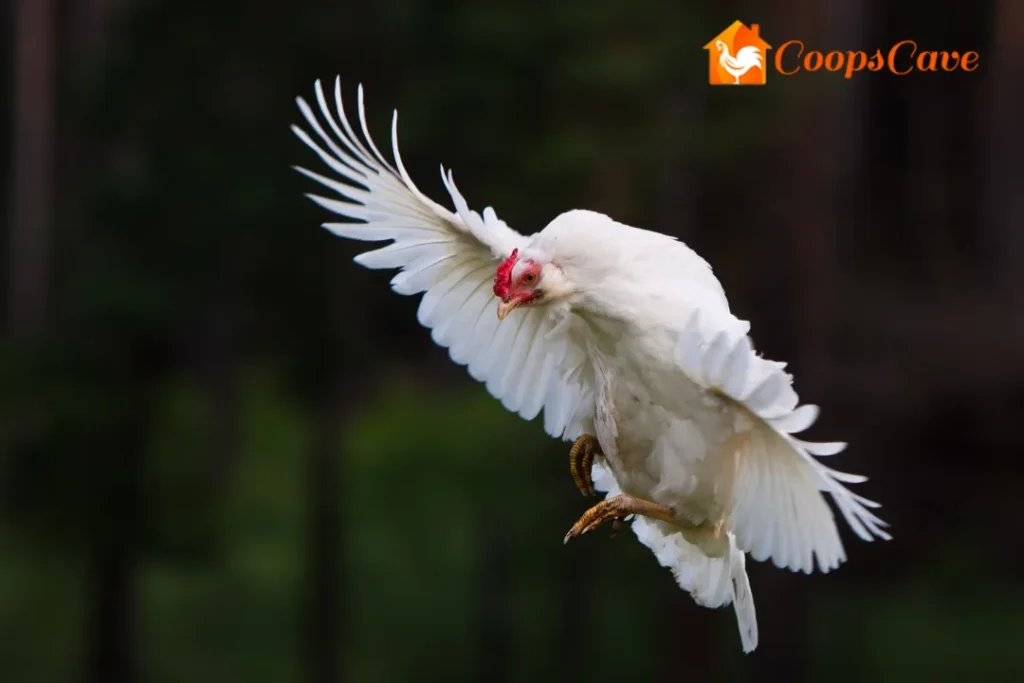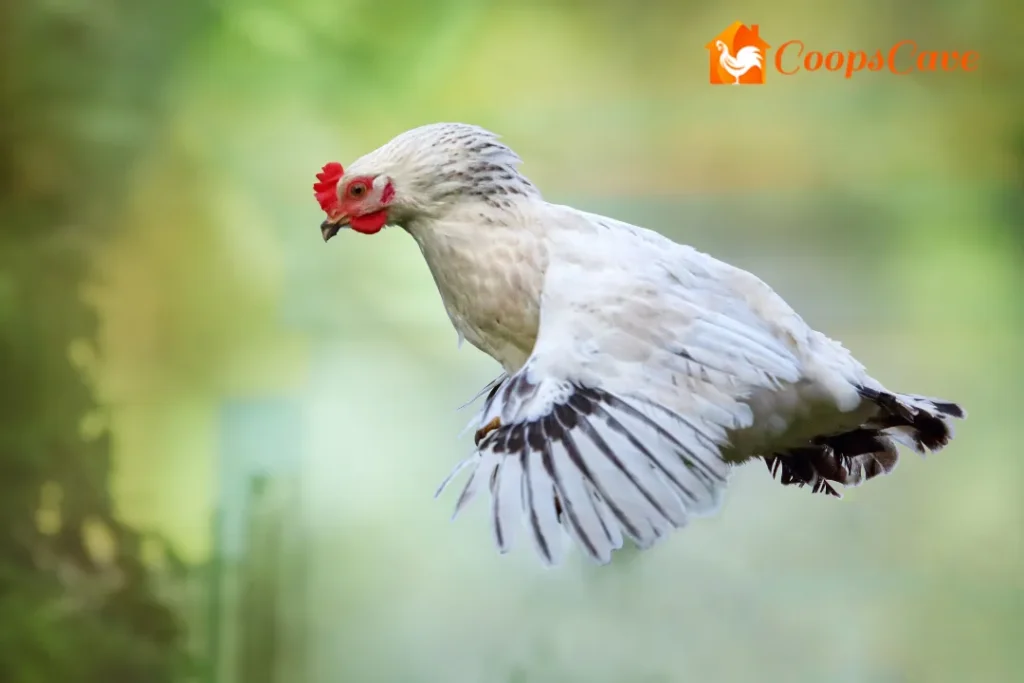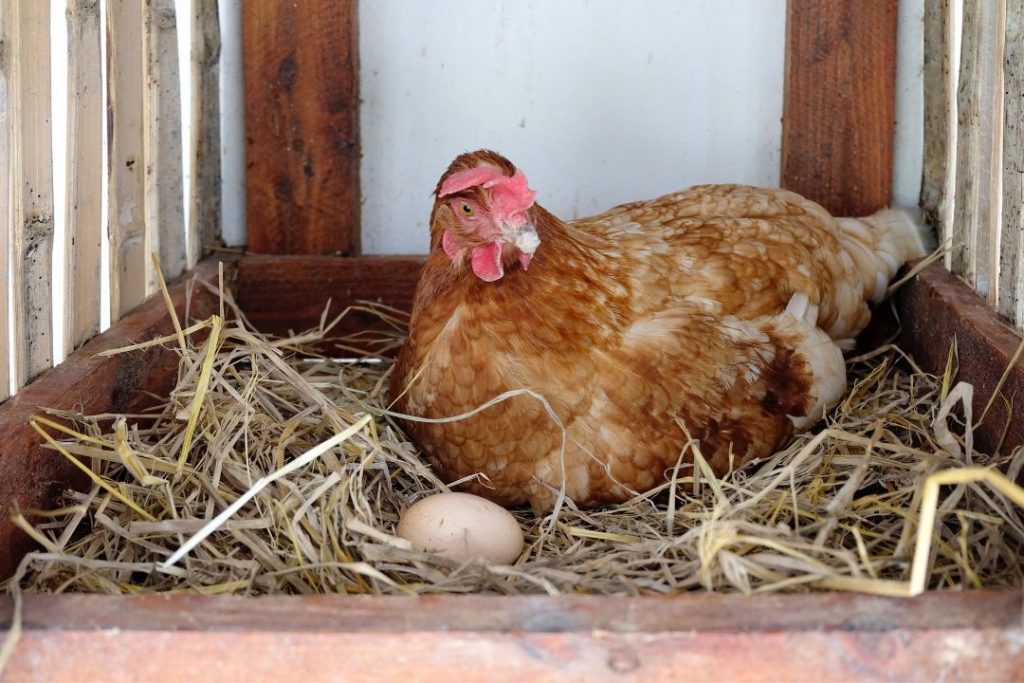Have you ever thought, “Can chickens fly?” Yes, that’s the clear answer! But not like you might think. Even though chickens have big bodies, they can fly. They use their flying ability as a survival mechanism to escape predators, reach food, or find the perfect roosting spot.
However, their flight is not a soaring journey across the sky. But rather than a short-distance hop-and-flap motion, they cover about 40-50 feet. The flight ability varies by breed, with lighter and bantam breeds being more capable.
But beware, their limited flight can lead to unexpected adventures over fences and into neighboring properties. So, how do you manage these flighty chickens? From providing higher perches to wing clipping for safety, there are strategies to keep your chickens grounded.
Dive into this comprehensive guide on “can chickens fly” and discover the fascinating world of these surprisingly airborne creatures.

Can Chickens Fly – A Detailed Explanation
Yes, chickens can fly but not far or high due to weight. They use flight to survive, escape predators, or reach food. Chickens start flying as chicks, and while most breeds can fly, heavier ones often don’t.
Chickens can fly over fences, with some reaching heights of 10-12 feet. However, their typical flight is a short-distance hop and flap motion. They can fly about 40-50 feet, with the longest recorded flight just over 300 feet.
Despite their limited flight, chickens can use it to escape enclosures, leading to problems with neighbors or exposing them to dangers. Solutions include providing higher perches, ensuring food availability, or wing clipping for safety.
How To Manage Flying Chickens?
When chickens take flight, no immediate action is needed as they instinctively return to their coop at dusk. If they remain safe on your property, daytime roosting may be harmless. To discourage fence-hopping, ensure food and water dispensers are full and accessible.
If your coop’s roosts are low, chickens may seek higher perches, exposing them to predators. To counter this, provide higher perches within the coop and limit free-ranging for a few days to adjust their roosting habits.
If necessary for the flock’s safety, consider wing clipping. However, remember that limited flight is a primary defense against predators.
Strategies for Handling Flighty Chickens”
1. No Immediate Action: Chickens naturally return to their coop at dusk. If they are safe on your property, no immediate action is needed when they take flight.
2. Daytime Roosting: Chickens may roost in trees or on structures during the day. This behavior is generally harmless and part of their instincts.
3. Food and Water Accessibility: Chickens may fly over fences for food. Ensuring that food and water dispensers are always full and easily accessible can discourage this behavior.
4. Provide Higher Perches: If the roosts in your coop are low, chickens may seek out higher perches, which could expose them to nocturnal predators. You can encourage safer roosting habits by providing higher perches within the coop.
5. Limit Free-Ranging: If you’ve added higher perches, limit free-ranging for a few days. This gives chickens time to adjust to their new roosting habits.
6. Consider Wing Clipping: If necessary for the flock’s safety, you might consider wing clipping. This inhibits a chicken’s ability to fly even short distances. However, remember that the ability to take limited flight is a primary defense for a chicken when encountering predators.
Why Do Chicken Fly?

Wild chickens, descendants of Asian jungle fowl, fly as a survival mechanism. This instinctual behavior allows them to escape predators and find safe roosting spots in trees at night. The ground-dwelling would expose them to greater danger.
Even domesticated chickens retain this instinct, with light-bodied hens often found roosting in trees if they don’t reach their coop in time. This high roosting behavior is a remnant of their wild ancestors’ instinct to seek safety from ground-based threats.
1. Curiosity and Determination: Chickens are inherently curious creatures. They love to explore new environments, especially if they suspect there might be food or interesting objects।
This curiosity can drive them to fly over fences or barriers to investigate what lies beyond. Their determination can also propel them to overcome obstacles, even if it means taking flight.
2. Escape from Predators: Chickens use flight as a means of escaping from predators. If threatened, they can quickly take to the air to evade danger. This survival instinct has been passed down from their wild ancestors, the jungle fowl.
3. Accessing Food and Resources: Chickens may fly for food or other resources. If they perceive better resources elsewhere, they may fly over fences or barriers to access them. This is particularly true if they see a lush garden or compost pile they want to investigate.
4. Excitement and Joy: Chickens may also fly out of sheer excitement or joy. For instance, if they see their keeper approaching with treats, they may fly toward them in anticipation. Similarly, they may take flight during play or when feeling particularly energetic.
5. Roosting: Chickens often fly to access their roosts. They may need to fly to reach them if their roosts are located at a height. This behavior is particularly common in the evening when chickens prepare to settle down for the night.
Chickens fly for various reasons, ranging from curiosity and excitement to survival instincts and the need to access resources or roosts. Understanding these reasons can help chicken keepers manage their flocks more effectively and cater to their birds’ needs and behaviors.
How Far Can Chickens Fly?
Chickens do possess the capacity to fly, albeit in a limited manner. Their flight is not characterized by long, soaring journeys across the sky but rather short, sporadic bursts that serve specific purposes.
The flight of a chicken is primarily dictated by its body weight. Domestic chickens generally have a body weight that is too heavy for their wings to carry them over extended distances.
Although it lacks grace, their flight is sometimes described as a blend of hopping and flapping. Chickens are naturally ground-dwelling creatures that favor foraging for food on the ground. If necessary, they will, however, use the air.
This may be done to avoid predators, roost, leave their run and travel to open country. Or occasionally establish supremacy among the flock. The distance a chicken can fly is relatively short.

Can Your Chicken Fly Over Fences?
Chickens, despite their limited flight capabilities, can indeed fly over fences. However, a chicken’s flying ability depends on different factors, including the fence height, the chicken’s breed, the hen’s motivation to fly over the barrier etc.
The chicken breed type significantly affects its ability to fly over fences. Lighter breeds and bantams, due to their smaller size and weight, are more adept at flying and can easily clear fences of considerable height.
On the other hand, heavier breeds may find it more challenging to overcome such obstacles due to their larger size and weight. The height of the fence is another crucial factor. A low fence poses little challenge to a determined chicken.
However, chickens, especially those of lighter breeds, have conquered even fences as high as six feet. For instance, some Red Stars have been observed to fly over six-foot fences, even after having one wing clipped.
This feat is achieved by hopping onto a midway point, such as a branch, and then flapping their wings to clear the rest of the distance.
The motivation of the chicken also plays a role in their ability to fly over fences. Chickens may be driven to fly over fences to escape confinement, explore new territories, evade predators, or access food resources.
Their flight is typically crooked, and their landing may lack grace, but they achieve their goal nonetheless. Chickens are not known for their flying prowess but can do surprising feats when motivated.
The ability to fly over fences is a testament to their adaptability and resourcefulness, demonstrating that they are more than just ground-dwelling birds.
At What Age Can Your Chickens Fly?
The ability to fly in chickens manifests at a surprisingly early age. Even as young chicks, chickens develop the necessary physical attributes and instincts for flight. This early onset of flight capabilities is a fascinating aspect of chicken behavior and development.
Chicks start developing wing feathers within just a few days after hatching. At this stage, their body weight is light enough to allow them to start experimenting with their wings. This early experimentation is the first step towards developing their flight capabilities.
For instance, a Wyandotte’s chick has been observed flying around a room like an expert at just over one week old, demonstrating the rapid development of flight skills in chickens. The growth of flight feathers, which are the long feathers on the wing’s leading edge, is a critical aspect of a chicken’s ability to fly.
Which Breeds Of Chicken Can Fly?
The ability to fly among chickens varies significantly across different breeds. While technically, most chicken breeds possess the physical attributes necessary for flight, the extent to which they utilize this ability can differ greatly.
Due to their small size and light body weight, Bantams are among the best flyers in the chicken world. Their compact size allows them to take off more easily compared to larger breeds. Bantam Sablepoots, for instance, frequently roost in trees, demonstrating their adept flying skills.
Lighter-bodied breeds, such as Araucanas, also exhibit good flying capabilities. Some chickens, like the hybrid Red Stars, seem to enjoy flying, often taking to the air for no apparent reason other than the sheer joy of it.
On the other hand, some light breeds, like Leghorns, prefer to stay grounded and forage rather than fly. Heavier chicken breeds, such as Orpingtons, Barred Rock, and Australorp, often struggle to get airborne due to their substantial body weight.
Their size and weight make generating the lift necessary for flight difficult. Similarly, ‘fancy’ breeds like Polish often avoid flying, possibly to prevent their elaborate feathers from getting ruffled.
Implications of Flight Capabilities in Chickens for Owners”
Chicken’s flying ability is limited but can have significant implications for those who keep them. Chicken owners can more effectively manage their flocks by understanding these implications.
Firstly, the flight capabilities of chickens can impact their interactions with their environment. Chickens that can fly over fences may venture into neighboring properties, potentially causing issues with neighbors.
Flying chickens can cause damage to gardens and lawns, turning lush green spaces into dust baths or foraging grounds. Therefore, chicken owners must consider these potential issues when designing chicken coops and runs.
Secondly, the ability to fly can put chickens at risk. While flight can help chickens escape ground-based predators, it can also lead them into danger. Chickens that fly out of their runs may encounter predators, traffic, or other hazards.
For example, the story of Lulu, a Red Star chicken, highlights the dangers chickens can face when flying into areas where dogs or other predators can reach them.
Finally, the flight capabilities of chickens can influence the management strategies chicken owners use. For instance, owners may need to consider wing clipping to prevent chickens from flying out of their runs.
What Are The Probable Solutions For Chickens That Fly?
Addressing the Challenges of Flight in Chickens: Possible Solutions”
The ability of chickens to fly, albeit limited, can present certain challenges for chicken keepers. However, several strategies can be employed to manage these challenges effectively.
1. Covering The Run
One of the simplest solutions to prevent chickens from flying out of their run is to cover it. This can be done using netting or a similar material.
The size of the run will determine the feasibility of this option. A smaller run can be easily covered, while a larger one may present logistical challenges.
2. Wing Clipping
Another common method to restrict the flight of chickens is wing clipping. This involves trimming the primary flight feathers of one wing, which unbalances the bird and makes sustained flight difficult.
3. Raising the Height of Fences
Can chickens fly over fences? If yes, consider raising your fence’s height. While this may not deter the most determined or able fliers, it can be enough to keep most chickens contained.
4. Selective Breeding
If the flight is a consistent problem, consider selecting breeds known for their limited flight capabilities in future additions to your flock.
While the flight of chickens can present challenges, several strategies can be employed to manage these issues. By understanding why chickens fly and the potential solutions, chicken keepers can ensure a harmonious and safe environment for their flocks.
Guidelines For Trimming Chicken’s Feathers
Chicken feather trimming is also called wing clipping. Chicken keepers employed this common practice to limit their chicken’s flying abilities.
Follow the step-by-step guide below to trim your flying chicken’s feathers:
1. Identify the Feathers to Trim
The primary flight feathers are the ones to be trimmed. These are the long feathers on the leading edge of the wing. In persistent ‘offenders,’ secondary feathers may also need to be trimmed.
2. Prepare Your Tools
Ensure you have a sharp pair of scissors or shears. Dull tools can cause unnecessary discomfort to the chicken.
3. Handling the Chicken
Hold the chicken gently but firmly. You may need a helper for this. One person can hold the chicken while the other does the trimming.
4. Extend the Wing
Carefully extend the wing to expose the flight feathers. You’ll notice a clear difference between the primary flight feathers and the smaller, softer feathers closer to the body.
5. Trim the Feathers
Using your scissors, trim the primary flight feathers. This should be done at a point level with shorter feathers to maintain a natural look.
Be careful not to cut into the feather shafts that are still growing, as these contain blood vessels and cutting them can cause the chicken pain and lead to bleeding.
6. Check Your Work
After finishing, fold the wing back to its natural position and ensure the trimmed feathers don’t protrude awkwardly.
7. Repeat Annually
Wing clipping is not a permanent solution. The feathers will grow back after the chicken’s annual molt, so you must repeat the process.
Remember, wing clipping aims to unbalance the bird’s flight, not to prevent it entirely. Therefore, typically only one wing is clipped. If you decide to trim your chicken’s feathers, do so responsibly and consider the potential impact on the bird’s ability to evade predators.
Wrapping Up
In conclusion, the question “Can chickens fly?” is met with a resounding yes, albeit with some caveats. Chickens, while not the most graceful or long-distance fliers, do possess the ability to fly.
Their flight serves important functions, from escaping predators to accessing food and roosting spots. However, their ability to fly can also present challenges for chicken keepers, necessitating wing clipping or raising fence heights to keep them contained.
Understanding chickens’ flight abilities and limitations is crucial for anyone involved in their care. It allows for better behavior management, ensuring their safety and maintaining a harmonious environment for these fascinating birds.



